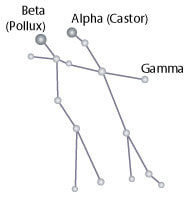|
This piece was originally broadcast on Radio Scilly in March 2019.
It’s been a glorious week for Scilly stargazers, with still, clear days turning into still, clear nights! What luxury, and after the disappointing Winter season, it’s been great to have several reliable nights in a row to gaze up and reacquaint ourselves with the starry blanket above! When I do have a clear night, I like to test out my knowledge of where the constellations are, piecing together the sky in a map. After lots of clouds, where you might be snatching moments to find a particular object, an open sky offers the chance to get back to basics. Here’s a constellation that will open up many others for you: Ursa Major, better known by its asterism name, the Plough. It’s got to be the most well known groups of stars in the sky. Most people can point it out. Lesser know, is its job as a navigation tool! The plough appears as 7 bright stars. You’ve got 3 forming the curved handle and then 4 forming a sort of bowl or shallow bucket shape. In France the plough’s known as the saucepan, for obvious reasons. There are actually 8 stars in the plough as the handle includes double stars Mizar & Alcor. If you look for the second star in from the end of the handle you’ll easily make it out as a pair with binoculars or small telescope. The brightest stars of the ‘pan’ part are those on the far right, Dubhe, top of pan & Merak bottom right of pan. To find Polaris, trace a line from Merak up through Dubhe, then extend that line 5 times, until you reach the Pole star, less than 1 degree from true North. Arc to Arcturus, by following the curve of the plough’s handle down, to reach distinctive bright, red star Arcturus in Bootes. Cross the top of the bowl, continuing past Dubhe, leads in the direction of Capella – cap to capella! And one more. Follow down the 2 stars of the pan nearest the handle (Megrez & Phecda), and you’ll reach Regulus, the brightest star in Leo. A hole in the bowl will leak on Leo, as the saying goes. There are even more, but give those a go for now. And here’s to many more clear nights!
0 Comments
 This piece was originally broadcast on Radio Scilly in March 2019. I do love this time of year when the nights start drawing back and you’re no longer walking to and from work in the dark. However the downside does mean later nights for us stargazers, and, potentially, the start of bleary-eyed mornings. That aside, the Spring constellations are slowly working their way into peak position in the night sky. Gemini and Leo are taking prominence high in the sky at the moment, with the very faint Cancer in between – if these names sound familiar it’s probably because you’ve read about them in the back of a magazine in your horoscope…and yes, they are constellations of the Zodiac. But I’m not talking about astrology or your ‘star signs’ here. Astrology – unlike astronomy – is not a science, although to be fair, they both involve the stars. That’s where it ends. Astronomy can explain the position of the stars in the sky, but frankly, it’s up to you and Mystic Meg to interpret their meaning. In astronomy, the Zodiac refers to the twelve constellations that our Sun passes through, identified back in the day by the ancient Babylonians. This area of sky also includes the apparent paths of the moon and the planets. We also call this imaginary line frequented by Moon, Sun and planets ‘the ecliptic’. Back to what you can actually see. Gemini is easy to spot, even for the most amateur of stargazers. It’s at its best right about now. You’ll spot Gemini northeast of Orion and it looks (if you join the imaginary dots) like two stick men holding hands. Apt, because Gemini represents the twins. Making it one of the few constellations that actually looks vaguely like what it’s called! The twins in question are Castor and Pollux from Greek mythology, inseparable brothers who became known as the Sons of Zeus. They were placed in the sky by dear old Zeus to honour their brotherly love. And there you are: Castor and Pollux are the names of the two brightest stars, which form the heads of our starry stick-twins. Back on Earth, we’re gearing up for the start of the season on St Martins, and our observatory will be open to the public from the beginning of April. For 2019 our regular openings –come rain or shine- will be Tuesday evenings and Friday afternoons, for a look around and fingers crossed some star (or sun) gazing. We will be open other nights, but those will vary week to week depending on the weather and interesting night sky events. If you’d like to visit or find out more, drop me an email, have a look at our website, or find our group on Facebook. Email: [email protected] Facebook: COSMOS Community Observatory St Martins on Scilly Here's a copy of the constellation anagram round, from one of the St Martin's quiz evenings. See how many you can get!
 This article originally appeared in Scilly Now & Then magazine's March edition. The Winter months haven’t been particularly kind this year for us stargazers, with cloudless nights rather lacking. As Spring comes upon us, sadly that does mean the nights grow shorter, however we’re ever hopeful for some better weather! The biggest news is that we now have an Observatory on St Martins. We’ve had time over Winter to get the kit set up and ready to use – though this has taken more time than we’d like, because you can’t configure a telescope when you can’t see any stars! Our biggest piece of kit is a 14 inch Meade telescope, quite a beauty. On our first proper go, we pointed it at the Moon – I took a very amateur picture just for posterity, out of sheer excitement. It was incredible: the amount of detail you can see, quite mind-blowing. Next to find the planets and deep sky objects. We’ll have to wait until Summer to see COSMOS favourites Saturn and Uranus at their best, but Mars is currently bright and red in the evening sky, to the West in Pisces. Our skies – when the clouds are elsewhere – offer a wonderful display at the moment, with recognisable constellations high in the sky: among them Orion, Gemini, Taurus (and therein the Pleiades), Auriga, Cassiopeia and Perseus. This patch of sky is great to learn to navigate with the naked eye, where we must start! Repetition is key to learning your way around. Learn the constellations and then explore within and around them. For example, I’ve learned by heart how to spot neighbouring spiral galaxy, Andromeda, using Cassiopeia as a pointer. It’s only by doing things again and again that you gain confidence. So it will be with the Observatory, in this, our first year of opening. As we step into the unknown, and open to the public, we have a plan but equally that plan will evolve (and, leitmotif alert, be subject to the mercy of our dynamic weather). We will be open ‘officially’ from 1 April 2019. The site will not be open all the time – as we’re a team of volunteers – but we have set openings on Tuesday evenings and Friday afternoons. These are fixed, come rain or shine. Plus we’ll be open other nights, confirmed nearer the time, for special events and talks. If you’re visiting Scilly this year, we’d love to see you on St Martins. Our website (cosmosscilly.co.uk) has all listed events, or email me for any additional info at [email protected]. Thank you for all your support in getting to this point. The Observatory really is a community project come to fruition, made possible by the belief and enthusiasm of many of you. Now it’s time to use it! |
BYCharlie Payne POSTS
September 2024
|


 RSS Feed
RSS Feed